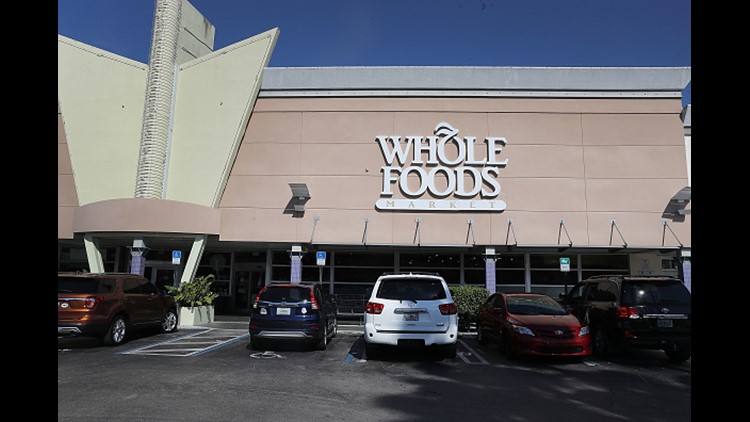Amazon said Friday it has agreed to buy Whole Foods Market for $13.7 billion, a stunning move to boost its grocery business even as the brick-and-mortar retail sector continues to sink under the weight of e-commerce.
In pursuing its largest acquisition ever, the Seattle-based online retail giant will pay $42 per share in an all-cash deal. That's 27% higher than Whole Foods' Thursday closing stock price of $33.06.
Despite Amazon's seemingly incongruent move, investors applauded the acquisition. Shares of Amazon spiked 3.4% to $996.46 in morning trading.
Other grocery stocks plummeted as investors contemplate an imminent industry shakeup and looming competition from Amazon. Kroger fell 13.4%. SuperValu was down 16%. Costco sank 7.5%.
The deal requires approval by Whole Foods' shareholders and regulators. The companies expect the deal to be completed in the second half of 2017. Amazon has to pay Whole Foods $400 million if the deal is not completed.
Amazon has dabbled in brick-and-mortar operations, experimenting with a bookstore that opened in New York last month and plans to open "no-checkout" convenience stores. But acquiring Whole Foods, with its 450 stores nationwide, represents a dramatic departure from its early business model founded on online retailing and related technology.
Grocery retail is a notoriously thin-profit-margin business. And Whole Foods -- often derided as "Whole Paycheck" -- has struggled in recent years to keep up with emerging competitors that are expanding nationwide with cheaper items. Traditional grocery stores, such as Kroger and Safeway, have also widened their organic food selections in hopes of retaining customers who are increasingly looking to eat healthy.
Sales of Whole Foods stores that have been opened at least a year fell 2.5% in 2016.
The Austin-based company also has had to fend off encroachment into its specialty sector by other big-box stores, like Walmart, that have been increasing their food sections and adding more healthy merchandise. Discounters, like Aldi, and other online grocers have made their way in, too. The supermarket sector got even more crowded on Thursday, when Germany-based discount chain Lidl opened its first 10 U.S. stores.
“Millions of people love Whole Foods Market because they offer the best natural and organic foods, and they make it fun to eat healthy,” said Jeff Bezos, Amazon founder and CEO, in a statement. “Whole Foods Market has been satisfying, delighting and nourishing customers for nearly four decades – they’re doing an amazing job and we want that to continue.”
John Mackey, Whole Foods co-founder and CEO, said the he agreed to the deal because it is "an opportunity to maximize value" for the company's shareholders. He will remain the company's CEO.
Whole Foods Market will keep its brand name and the headquarters will remain in Austin.
Dissatisfied with Whole Foods' lagging sales and turnaround plans, activist investors, like Jana Partners, have been pinching its executives for more aggressive moves to reinvigorate the company.
Last year, Mackey grabbed firmer control after eliminating its dual-CEO structure. He then promised to streamline operations by closing some stores, offer better prices, come up with ways to entice customers to buy more products per trip and invest in digital commerce.
Jana Partners bought more shares in April, becoming Whole Foods' second largest shareholder, to agitate the company's executives for further changes. Whole Foods responded by remaking its board of directors and replacing the chief financial officer.
“They’re under a lot of pressure to create shareholder value and turn back to a growth story," said Greg Wank, head of the Food and Beverage Industry Group at New York-based accounting and consulting firm Anchin Block and Anchin. "They see this as an opportunity to leverage Amazon’s incredible retail online strength to perhaps gain the growth that’s coming from all the consumers moving to online platforms,”
From Amazon’s perspective, it’s a way a quick way to grab a larger share of the grocery sector, which they’d begun with AmazonFresh and pilot stores. “It’s a quick opportunity to become a real player and start doing their favorite thing, which is clicking on Walmart’s heels,” Wank added.
Grocery sales are increasingly crucial to Amazon’s ability to sustain its phenomenal growth rate simply because food represents a big portion of consumers on-going purchases. The U.S. grocery market is worth $750 billion annually and the average American family visits the grocery store twice a week.
Whole Foods is a well-targeted acquisition because the Whole Foods shopper is the Amazon shopper, said Cooper Smith, an Amazon analyst with business intelligence company L2.
“Amazon's strategy is to be the top grocery store for the coastal cities that are really Prime territory,” Cooper said, referring to its shopper membership program. “Think San Francisco, New York, Boston, Austin. That’s their ecosystem. That’s where the Prime members are.”
Amazon also could be looking at Whole Foods for more than just selling groceries. With its stores often placed in well-heeled neighborhoods, the deal makes a “huge leap ahead” possible, said Phil Lempert, a food marketing analyst.
“This gives them a place for Amazon lockers, for pickups," he said. "There’s a ton of stuff they can do with this real estate.”
Follow USA TODAY reporter Roger Yu on Twitter @ByRogerYu.



